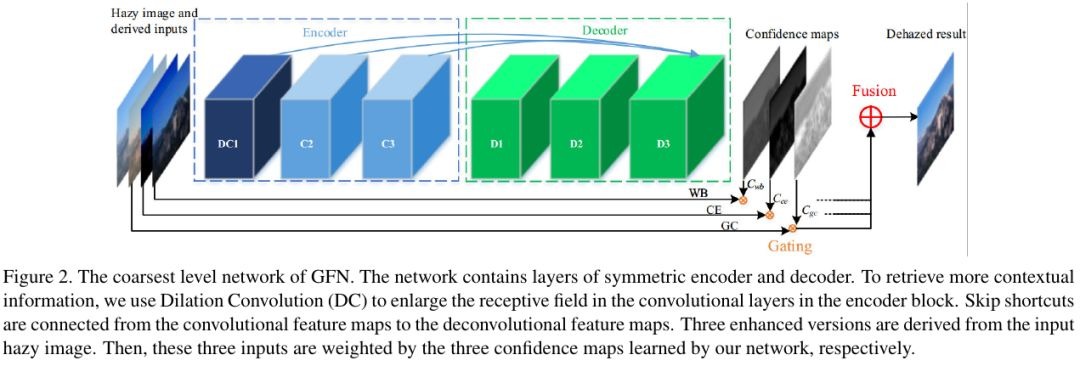Ren W, Ma L, Zhang J, et al. Gated fusion network for single image dehazing[C]//Proceedings of the IEEE Conference on Computer Vision and Pattern Recognition. 2018: 3253-3261.
1. Overview
1.1. Motivation
Most existing methods follow the atmosphere scattering model.
In this paper, it proposed Gated Fusion Network (GFN)
- directly restore a clear image from a hazy image
- encoder-decoder
- fusion-based strategy + confidence maps. White Balance, Contrast Enhancing and Gamma Correlation
- multi-scale to avoid halo artifacts
- GAN loss

1.2. Major Factors of Hazy Image
- color cast introduced by atmosphere light
- lack of visibility due to attenuation
- solution
- WB. eliminating chromatic casts
- CE. better global visibility in thick hazy region but too dark in light hazy region
- GC. recover the light hazy region
1.3. Contribution
- Network not follow the atmosphere scattering model
- demonstrate the utility and effectiveness of GFN
- multi-scale approch to eliminate halo artifacts
1.4. Related Work
1.4.1. Multiple-image aggregation
1.4.2. Hand-crafted Priors Based Methods
- maximize the contrast
- dark channel
- color-lines
- non-local
- fusion luminance, chromatic and saliency maps
1.4.3. Data-driven Methods
- combine four feature with Random Forest
- color attenuation prior
- deep learning
1.5. Dataset
A∈(0.8, 1.0), β∈[0.5, 1.5]. random sample 7 groups, add 1% Gaussian noise.
- Train. 1400 images x7
- Test. remained 49 images x7
- RESIDE dataset. benchmark
2. Network

2.1. White Balance Input
- recover the latent color of the scene and eliminate chromatic cast
- but still present low contrast
2.1.1. Gary World Assumpation
the average value of the R,G,B components should average out to a common gray value. (Link)

2.2. Contrast Enhanced Input
- subtracting the average luminance value
- dark image region tend to black

2.3. Gamma Corrected Input
- overcome the dark limitation of CE


2.4. Network
- dilation Conv
- Relu
- 3 Conv + 3 DeConv, stride 1
- first layer 5x5, other 3x3x32

2.5. Multi-Scale Refinement

- vary the image resolution (x2) to preserve halo artifacts
- loss function

- motivation
the human visual system is sensitive to local changes (e.g., edges) over a wide range of scales. As a merit, the multi-scale approach provides a convenient way to incorporate local image details over varying resolutions.
2.6. GAN Loss
apply to finest image.

2.7. Total Loss

3. Experiments
3.1. Details
- 128x128 patches, batch size 10, 240,000 iteration
- Adam, 0.0001 LR, LR decay
- weight decay 0.00001
- train 35 hours on K80
3.2. Comparison

light, medium and heavy (β=0.8, 1.0, 1.2).


3.3. Ablation Study
Multi-scale

Gated Fusion

3.4. Limitation

- can not handle very large fog